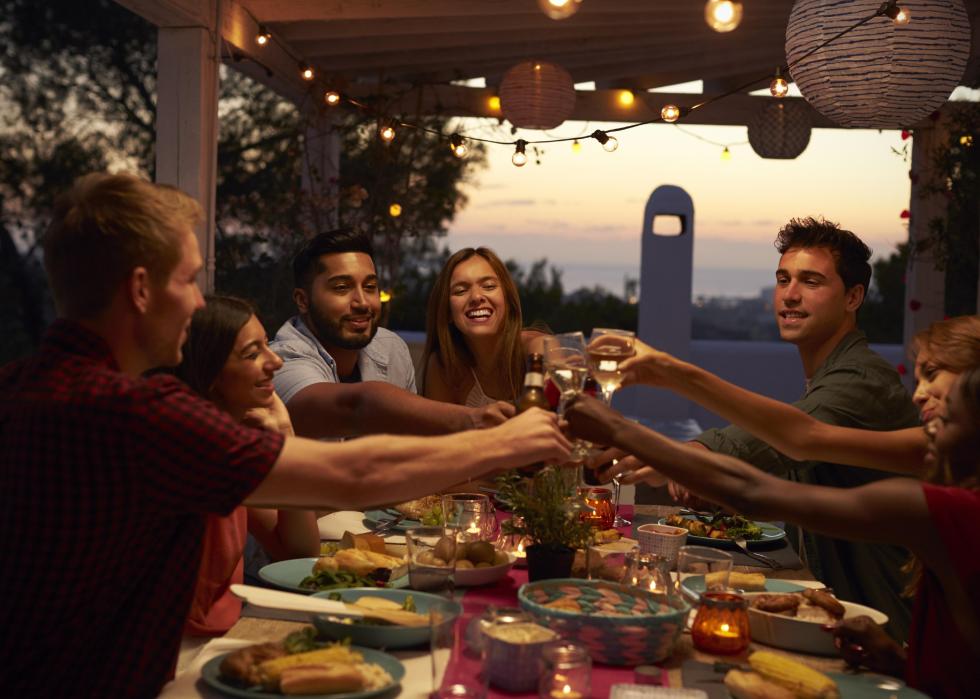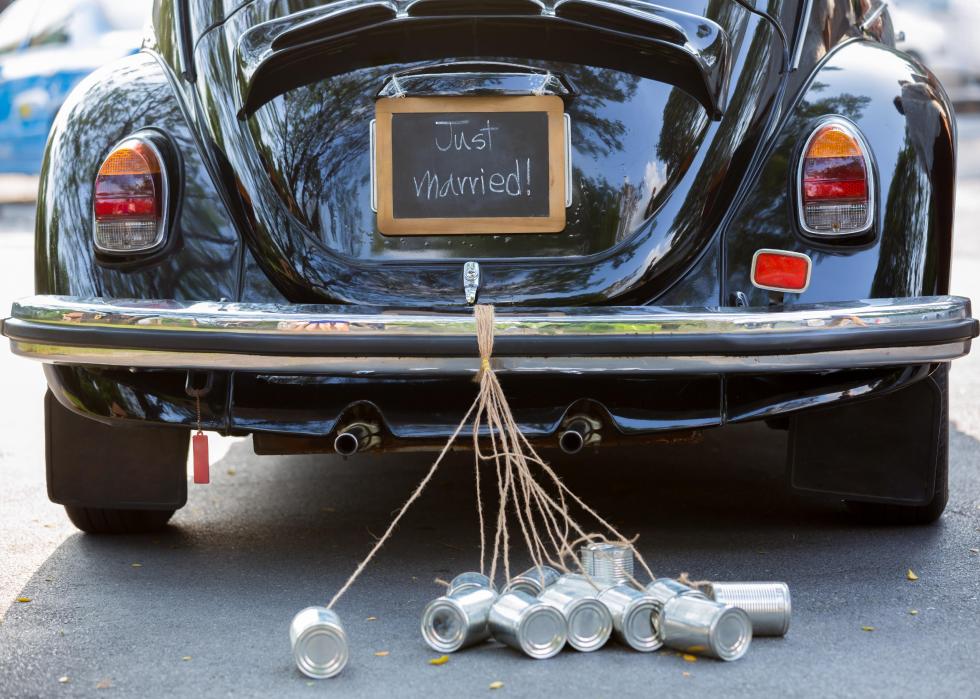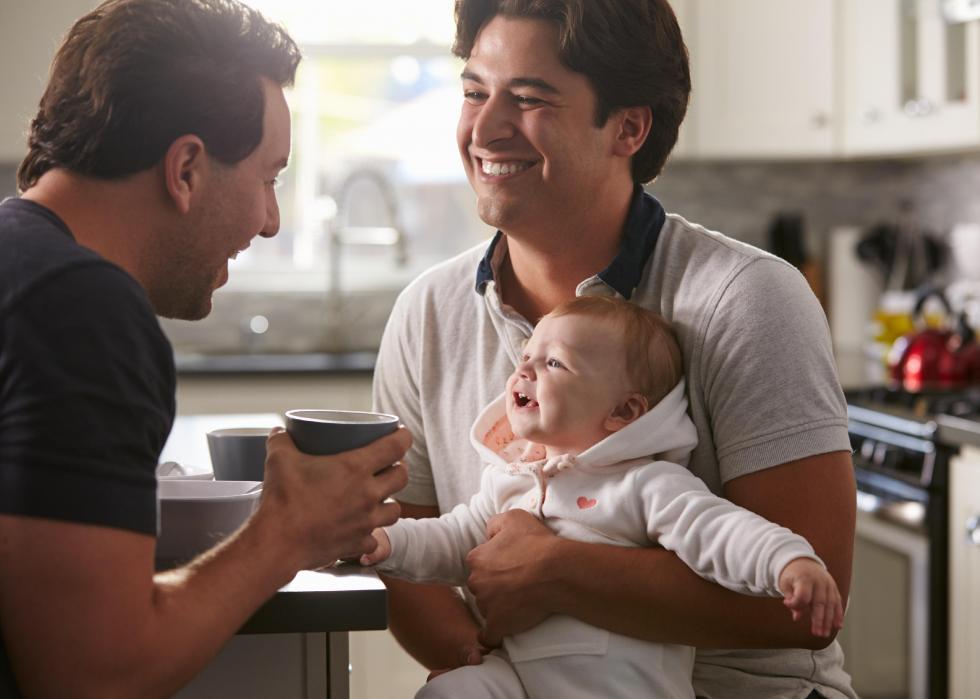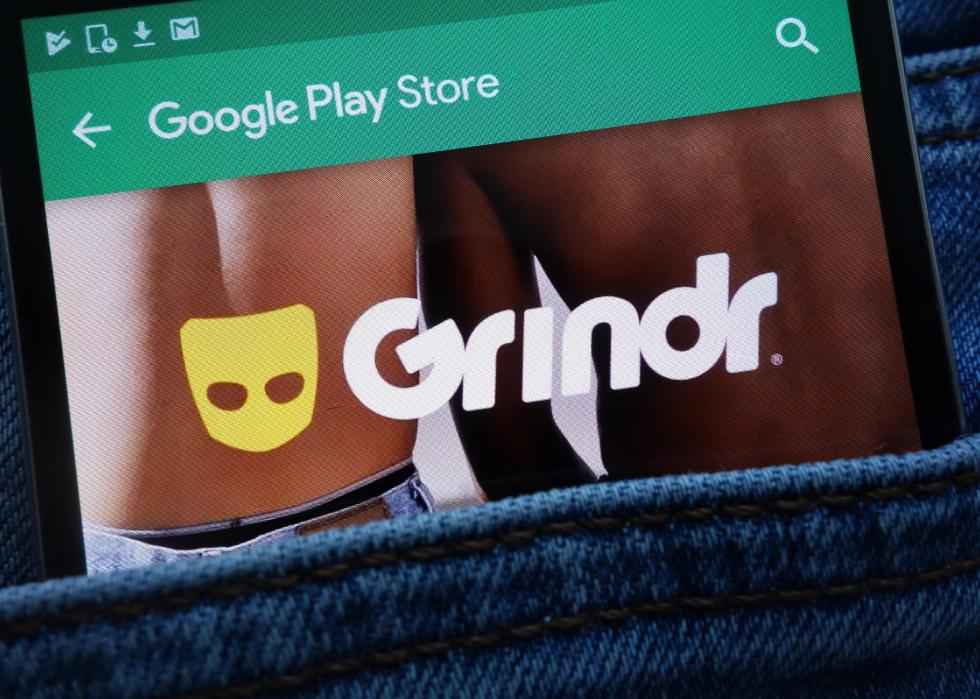
What data says about love in the 21st century
Love may be among the "most studied and least understood areas in psychology," writes Susan Krauss Whitbourne, professor emerita of Psychological and Brain Sciences at UMass Amherst. From dating and marriage to family ties and friendships, extensive research and compiled data provide insights into a nebulous and forever-changing element of the human heart.
Data demonstrates how much views on marriage—"once considered the most legitimate way to be in a relationship, to have sex, and to have a family," according to author and professor Kristin Celello—have changed. In her interview with Refinery29, Celello discussed how the feminist movement in the 1970s America influenced perspectives, helping inspire women to become more financially independent and have relationships on their terms.
Today, divorce rates are up while marriage rates are down. More people have cohabited with a romantic partner than have been married. The staggeringly high cost of an average wedding in America—along with the history attached to the institution of marriage—are both reasons people cite for avoiding marriage altogether. The Knot reported that the average cost of a wedding across the U.S. is $33,931. This, combined with the fact that more middle- and upper-class people get married than poor and working-class adults, helps show marriage today can be a sign of privilege. The "sordid history" that comes with marriage is one reason that the anonymous blogger of A Purple Life pointed out that a generation ago, in most states, she wouldn't have been legally allowed to marry her white partner since she is black.
The data doesn't end there: Eighty-eight percent of respondents to a 2013 Pew Research poll about love in the United States said love is the most important reason to marry, followed by making a lifelong commitment to someone (81%) and companionship (76%). Fewer people say having children (49%), religion (30%), financial stability (28%), and for legal rights and benefits (23%) are very important reasons to wed. While it's important to note that these numbers represent ideals (not everyone marries for love), the data helps to illustrate shifting social and cultural attitudes.
And we're just scratching the surface. To find out more about what data says about love in the 21st century, Stacker took a hard look at Pew Research and Gallup studies, mined data from dating sites such as Tinder and OkCupid, and reviewed studies published in scientific journals and government reports. From online dating to same-sex relationships, marriage and divorce, read on to find out what data says about love in America today.

51% of 18- to 34-year-olds in America are single
Young Americans today are 18% more likely to be single than their 2004 counterparts, according to 2018 data from the General Social Survey conducted by the National Opinion Research Center at the University of Chicago. The study found that 51% of 18- to 34-year-olds in America are without a steady partner. It's not just the Gen Zers and millennials opting for the single life, either: The percentage of singles in the overall public reached an all-time high in 2018 at 35%.

Democrats more likely to be single than Republicans
2018 data from the General Social Survey also found that Democrats are more likely than Republicans to not have a steady partner: 41% of Democrats are single versus 29% of Republicans. When Gallup analyzed more than 29,000 interviews in 2009, they found marriage was a key indicator of party identification but pointed out that this is nothing new. Gallup's Jeffrey Jones wrote in 2008 that there has been a clear marriage gap in voting preferences since at least 1996 when they began gathering data.

Different political views are harder to overcome than different religions
For Americans, having different political views is a greater hindrance to a relationship than belonging to different religions. In 2014, 39% of those married had a partner from a different religion than their own, according to a Pew Research Center survey. Another Pew study in 2016 reported that 77% of both Democrats and Republicans were either cohabiting with a partner or married that belongs to the same political party, making relationships crossing political party lines a rarity.

Similar personalities are not necessary for relationship well-being
While research has shown an attraction among those with similar personalities, a 2010 study published in the Journal of Personality and Social Psychology proved that similar personalities or attitudes did not influence the well-being of a relationship. However, researchers from the University of Amsterdam took a more nuanced approach to understand the impact similarity has on relationship happiness in 2019. They found the effect of similarities depends on specific traits and the level at which each partner possesses said traits.
For example, it wasn't better for both partners to have low conscientiousness levels, but it was optimal for both partners to possess some similarities in openness.

Exposure to romance in media impacts beliefs about love
Media in all of its forms continues to impact all aspects of life, including love. University of Michigan researchers found that college students with more exposure to romantic films were more likely to believe love overcomes obstacles. Increased exposure to marriage-themed reality TV shows also led to "idealization" about love, such as believing in love at first sight. The same couldn't be said for students who watched a higher number of sitcoms—they had a more negative view of romance.

Views on same-sex relationships are becoming more positive
Americans are becoming more accepting of same-sex relationships—a point illustrated by the landmark decision in June 2015 to legalize same-sex marriage throughout the United States. A 2019 report by Pew found that half of Gen Zers and millennials believe same-sex marriage is a positive thing for society while 33% of Gen Xers, 27% of boomers, and 18% of the silent generation agree. For the first time, the 2020 census will differentiate between same-sex and opposite-sex couples, meaning we may have more accurate information on same-sex relationships in America than ever before.

Millennials more open to dating beyond borders
Millennials are more open to dating people from different backgrounds or countries, including those who speak a different language, according to the 2018 "Language of Love Report" published by dating site OkCupid in partnership with software company Rosetta Stone. More than half of age groups 37–53 and 54 and older felt it was important that both couples are from the same country, but only one-third of millennials agree.

39% of heterosexual couples meet online
The most likely way for someone to meet the love of their life used to be the old-fashioned way: through a mutual friend, common interest, or in public spaces like bars or parks. The first online dating site, Match.com, started up in 1995, introducing an eventual phenomenon. Today, online dating is the most common way people meet, according researchers from Stanford University the University of New Mexico. Of heterosexual couples that began a relationship in 2017, 39% met on the internet. Earlier research published in the Proceedings of the National Academy of Sciences looked at marriages taking place between 2005 and 2012, finding that one-third of the unions began online.

60% of same-sex couples meet online
Sixty percent of same-sex couples who got together in 2017 met online. Online dating allows for members of the LGBTQ+ community to connect with people outside of their real-life social circles, which is especially valuable for those living in conservative areas not as welcoming to gay people visibly dating. Working with GLAAD, Tinder announced the introduction of the "orientation" feature in the U.S. and other countries. Users can select three terms they believe describes their sexual orientation and choose to share those terms on their public profiles and select whether the app should order matches based on orientation.

Online dating is more culturally acceptable
There was a time not so long ago when many believed the stigma surrounding online dating sites and the people who used them, but this is changing. "People used to make up stories about how they met, so they wouldn't have to admit that they met online, but now many people embrace it," said researcher Rueben Thomas, author of the paper "How Couples Meet and Stay Together." In 2005, 29% of people believed that dating site users were "desperate"—this number was 23% in 2015, according to Pew Research. In 2015, 59% of people felt "online dating was a good way to meet people," up from 44% in 2005.

54% believe other users misrepresent themselves online
Pew Research Center's "Internet & American Life Project" in 2013 found that 54% of online daters felt other users have "misrepresented themselves in their profile." As online dating became increasingly common, MTV in 2012 introduced its hit show "Catfish," featuring "sensationalistic cases" that have fueled the perception that people should be particularly suspicious of those they meet online, suggests Gwendolyn Seidman in a 2014 article published by Psychology Today. A study published in a 2018 issue of the Journal of Communication found that deception is actually quite rare in online dating, with most lies told to look better, to avoid meeting, or to be kinder when rejecting another person.

Using the word 'love' could help you find it
Actually, using the word "love" in your dating profile just might help you find the real thing, according to a PlentyofFish study in 2014, which analyzed 1.2 million profiles on their dating site. A few other words benefit men, as well, including "children," "heart," "relationship," and "romantic."

Women are more likely to get responses online dating
OkCupid reports that when women are the first to reach out, they are 2.5 times more likely than men to get a response. The dating site also found that being a feminist didn't impact whether they would make the first move—and less than 1% of all straight women prefer to pursue a potential partner.

28% of online daters have felt harassed on a dating site or app
Dealing with harassment is a common issue for people looking for love online, with 28% saying they have dealt with feeling harassed on a site or app, according to Pew's "Internet & American Life Project." Although a person of any gender can experience harassment while online dating, women face it more than men: 42% of women and 17% of men have reported feeling harassed.

Gen Z more likely to mention causes in dating bios
Values tend to change from one generation to the next and can be clearly illustrated by what daters are looking for in a potential love connection. Tinder reported in 2019 that Gen Z was more likely to call out to missions or causes dear to them in their profiles while millennials were three times more likely to refer to travel.

75% have had three long-term relationships (so far)
Three-quarters of American adults have had an average of three long-term relationships in their lives so far, according to a YouGov survey of 1,000 people in 2015. FiveThirtyEight's Mona Chalabi points out the age of respondents is important to note, as those 18 to 29 years old were by far more likely to report having no long-term relationships than older age groups. While many believe a long-term relationship will inevitably go stale, multiple studies have shown that romantic love can thrive for decades. Research published in a 2011 issue of Social Cognitive and Affective Neuroscience found there was similar brain activity in two groups: individuals married for an average of 21 years and those who only recently fell in love.

69% say cohabitation is acceptable
Cohabitation, whether a couple plans to get married in the future, is accepted by 69% of Americans, according to 2019 research from Pew. People younger than 30 are more likely to feel this way (78%) while 63% of respondents 65 and older agree. While cohabitation doesn't automatically mean a couple will get married, two-thirds of married people lived with their partner before the wedding and 44% of cohabiting adults say they see cohabitation as a step closer to getting married.

More adults have cohabitated than have been married
Americans in the 18- to 44-year-old age group are more likely to have cohabitated with an unmarried partner than have been married. This data is based on a Pew Research Center analysis of the National Survey of Family Growth, which reports that 54% of this age group in 2002 had lived with a partner outside of marriage and 60% had been married before.

Cohabiters say finances are why they're not married yet
Many cohabiters would like to get married, but say that finances are the reason they haven't gotten engaged or married, according to 2019 data from Pew. Roughly three in 10 adults in cohabiting relationships cite their own or their partner's lack of financial readiness as a major reason they haven't taken the next step—less say it is because they are not ready (14%).

Average engagement length is 13.6 months
Out of 14,000 couples married in 2018, the average engagement length was 13.6 months, according to The Knot's 2018 Real Weddings Study. Marriage and infidelity expert Scott Haltzman suggests a longer engagement can allow couples to develop skills that can improve marriage through premarital education.

Marriage rates continue to decline
While there were actually less married couples in 1960 compared with 2018, the U.S. marriage rate continues to fall among Americans. The marriage rate in 2018 was 6.5 per 1,000 people of the population while in 1990 this number was 9.8. While 88% of Americans believe love is a very important reason to marry someone, Pew reports that 71% of adults also consider it very important for men to financially support their family (only 32% said the same went for women). In the 2019 study, "Mismatches In the Marriage Market," Cornell University researchers suggest there are large deficits in the supply of potential male spouses: "Most American women hope to marry but current shortages of marriageable men—men with a stable job and a good income—make this increasingly difficult, especially in the current gig economy of unstable low-paying service jobs," said lead author Daniel Lichter.

Age of first-time newlyweds continues to grow
The average age of first-time newlyweds in America has been on a slow rise for the most part since 1890, according to data from the U.S. Census Bureau. In 2018, the average age for a woman on her first wedding day was 27.8 and for men, 29.8. The age gap between married couples has also decreased; while historically women were three years younger than their male partner, now the gap is an average of two years.

More newlyweds are married to someone of a different race
Only 3% of newlyweds in 1967 were married to someone from a different race, according to Pew; in 2015, that number reached 17%. More Americans today are also less likely to oppose interracial marriage in their families—10%, down from 31% in 2000—and 39% of people now believe interracial marriage is beneficial for society, compared with 24% in 2010.

Marriages ending in divorce average seven years
The seven-year itch may not be a myth: As far back as 1867, marriages that end in divorce lasted an average of seven years, according to the CDC. Researchers have attempted to uncover why this is the case, with some researchers focusing on evolution.

Incompatibility, infidelity, finances top reasons for divorce
Various studies have tried to determine the most common reasons for divorce, and while the reasons vary, especially in studies that allowed for open-ended answers, trends do emerge. The top reasons cited for divorce include incompatibility, infidelity, money issues (in order), according to a study conducted by the Institute for Divorce Financial Analysts.



